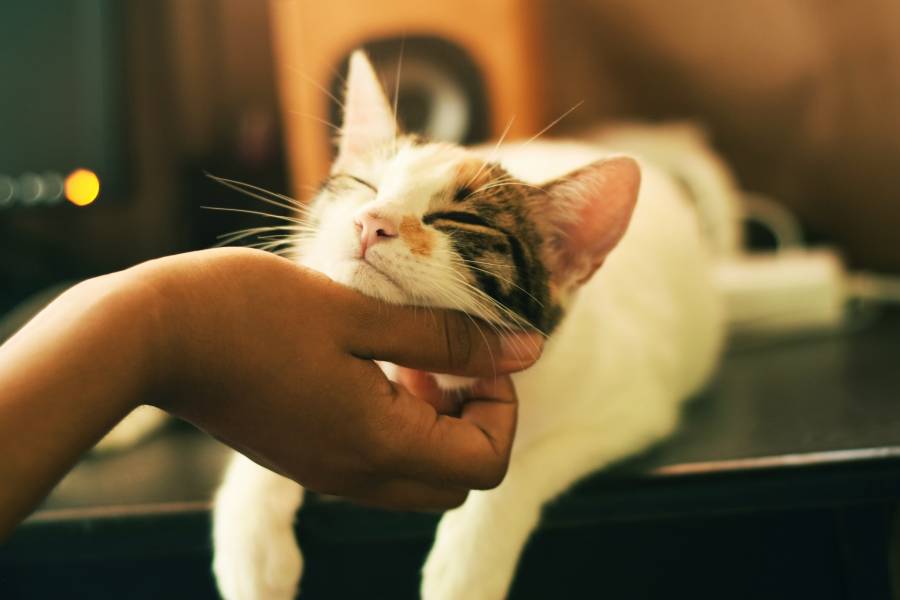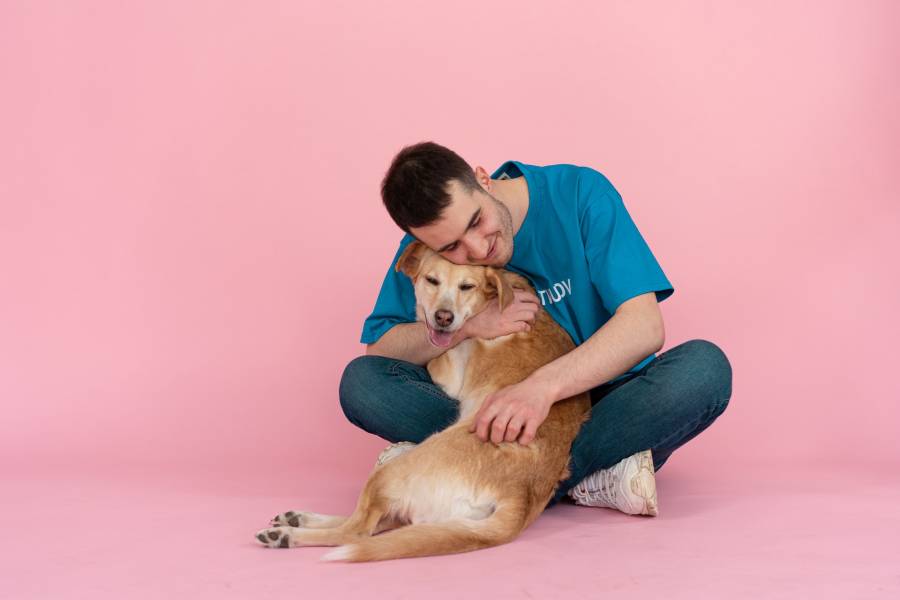Quick Navigation
Our beloved pets are very fond of expressing themselves through body language; these animals also like it when we pet them.
It is no secret that they love to be caressed on the back and sometimes other body parts.

The animals’ facial expressions and body movements indicate the joy of being petted.
In addition, these strokes and pats seem to offer some benefits, making many animals like it when we pet them.
Reasons Why Animals Love Being Pet
1. Pleasure
One of the main reasons animals love being petted is that they enjoy it.
It applies to animals used to being petted, especially by a familiar face.
Beneath animals’ skin are nerve endings, and physical touch is communicated to neurons in the brain.
These neurons send signals to the brain, and the brain delivers pleasure to the rest of the body.
So animals familiar with being petted would be excited to be petted again.
It is because the animal remembers the feeling of pleasure when the animal was petted previously.
2. Comfort
The emotions of animals are not quite different from humans.
Sometimes our pets can find themselves in a strange place like the vet or a loud environment filled with strangers.
When this does happen, they tend to feel unrelaxed and tense.
However, if they are petted, it can help animals feel relaxed, calm, and at ease (comfortable).
Animals love it when they are comfortable and petted in the right hands.
There are also cases when the animal can seem depressed or overworked.
Petting them can lighten up their mood and relieve some of that stress, making them feel comfortable.
Besides, there isn’t any animal that doesn’t love to relieve stress else; they will get drained emotionally.
3. Create A Social Bond
Most animals are fond of interacting and creating social bonds with animals of the same species, sometimes with different species.
Even though we belong to different categories, all animals create bonds with physical interactions.
Physical interaction establishes a connection that is built on trust.
In addition, one of the ways of building a connection with animals is by providing food and shelter.
The mutual benefits gained from the physical interaction or petting create a bond that makes animals love to be around us.
4. Grooming Technique
How strokes and pats move across an animal’s body feels the same as being groomed.
It depends on the intensity, but animals love to groom themselves to an extent.
The extent to which an animal is groomed depends on the desired level of feeling groomed.
Some animals of similar species groom themselves and help each other relieve an itch or remove unwanted parasites.
Since animals love the idea of being groomed, the idea of petting places where they can’t reach makes them love being petted.
5. Keep Warm
We look for places to keep us warm when we feel cold, even as humans.
Back in the day, to keep warm, we used thick clothes, lit up a fire, and stayed at the edge of the fire to keep warm.
Sometimes, we use our body heat to keep warm in extreme cold weather conditions.
During the first snap of cold weather, some animals use the body heat of other animals to keep themselves warm.
Aquatic animals like turtles require excessive heat from the basking area to keep warm.
Some animals have fur and feathers to keep them warm.
Regardless, they wouldn’t mind snuggling and cuddling while being petted to regulate their body temperature.

6. Increase Stimulation
When animals are being petted, they release a hormone that increases stimulation.
It applies to both the owner and the animal.
When soft strokes are delivered on the animals’ skin, the owner and the animal release a hormone called oxytocin.
This hormone can help increase activity rates (physical and sexual).
Moreover, the feeling of releasing oxytocin and increasing stimulation around the body makes animals love being petted.
7. Feel Safe
Animals do have long-term memory.
For instance, if a predator chases an animal in fear, the animal will avoid the predator in the future.
The reverse applies when an animal is welcomed with open arms with no sign of predators.
If an animal is provided with food, shelter, snuggled up, and petted, the animal does not have a reason to flee.
Animals love being snuggled up and petted; it makes them feel safe and secure.
Remember not to approach an animal harshly, especially when your movement goes unnoticed around them.
They could feel frightened and react harshly in return.
8. Promote interaction
A lot of petting and snuggling means an interaction with the animal.
Animals will understand the needs of the owner and vice versa.
In cases where the animal lives solitary, interactions are good for the owner and the animal.
For instance, dogs and cats can wreck the house without learning the dos and don’ts in search of their play toy.
Personal training to discourage bad behavior should be conducted as soon as the animal is welcome to the household.
In addition, good behavior should be encouraged with treats and a pat on the head.
Words like “good boy” and “good kittie” can be said to encourage good behavior.
Animals are bound to love being petted when there is excellent communication between the owner and the animal.
9. Attention
Animals found alone in a home can suffer from depression and develop separation anxiety.
Most animals love getting attention from owners, and the most common way to do that is by petting the animal.
The animal might require attention because the animal wants to exercise or wants a good rub.
Regardless, animals love spending time with their owners, and petting them is good for their mental health.
10. Affection
The first love an animal can receive is from its mother.
Mothers will groom and feed their young ones until they can fend for themselves.
It is how mothers show affection and make their young ones feel safe.
When we pet animals, it reminds them of the love and affection they received first from their mothers.
Animals love to be shown affection, and petting them does just that; no wonder they like it so much.
Even though we do not look like their mothers, petting and feeding will remind them of their first affection.
Specific Examples
While most animals enjoy attention when you are petting them, the extent differs from one animal to another.
Take, for example, cats and dogs.
Cats like it when you rub them because while it can be likened to their grooming routine, it could also feel like when they were still kittens.
Typically, a mother cat would lick them to clean them and care for them.
But like all cats, they only want to be petted up to a certain extent.
Most dogs also respond positively when you pet them, and they may encourage you by lying flat on their backs and with their bellies open.
Meanwhile, most marine animals don’t respond to petting as cats and dogs do.
Why Humans Like Petting Animals
While animals like being pet, we also like petting them, primarily because of the pleasant sensation when their soft fur touches our skin.
In return, we respond with positive emotions toward our pets and, at the same time, reap psychological benefits such as comfort and reduced stress.
Summary
The reason why our pet animals like it when we pet them depends on the animal.
Different animals have different reasons why they love being pets; some animals share mutual reasons while others don’t.
Regardless, animals love a gentle stroke on some body parts and sometimes snuggles that make them feel loved.
It also includes humans too.
Even though animals love being petted, petting provides numerous benefits to the animal and the animal lover.
Petting an animal can reduce stress, lower blood pressure, boost mental health, and much more.

Purrfect n’ Pawesome is the brainchild of Amanda, who has been into researching and writing about pets to help other pet parents in nurturing their adorable pets. Currently, she runs Purrfect n’ Pawesome along with her team of experienced and dedicated pet experts. Along with being an awesome writer and entrepreneur, Amanda is a cat mom to two innocently spoiled cats, Balanca and Scruffy.
She has been writing about pet care and nurturing and wants to share her readers’ experiences, learnings, and knowledge.
Over the years, she had the opportunity to work with various pet owners having multiple breeds, and that exposure gave her experience and the lessons of a lifetime.
Her family, her entire universe revolves around her two cats, who give her endless support and inspiration to move ahead with her objectives in life. Amanda is a live example of a balanced approach to all parenthood questions we all face in life.






![Why Is My Fish Swimming At The Top Of The Tank? [Explanation] Why Is My Fish Swimming At The Top Of The Tank? [Explanation]](https://purrfectnpawesome.com/wp-content/uploads/2021/03/Why-are-my-fish-swimming-at-the-top-of-the-tank-150x150.jpg)